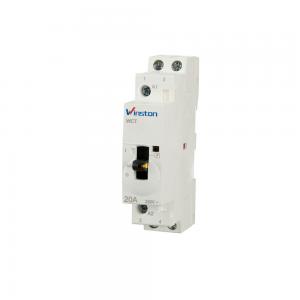

Add to Cart
AC contactor belongs to modular controlling electrical equipment, which has novelty structure, compact size , it is DIN-RAIL for installation, size of modular, modeling artistic. use of safety, direct acting inversion. And, it can install in the distribution boards along with breakers.
| Power circuit | ||
Voltage Rating(Ue) 1P, 2P | 250VAC | |
3P, 4P | 400VAC | |
Endurance(O-C) | ||
Electrical | 100000 cycles | |
Maximum number of switching operation a day | 100 | |
Additional characteristics | ||
Insulation voltage(Ui) | 500VAC | |
Pollution degree | 2 | |
Rated impulse withstand voltage(Uimp) | 2.5kV(4 kV for 12/24/48V AC) | |
Degree of protection (IEC 60529) | Device only | IP20 |
Device in modular enclosure | IP40 | |
Tropicalization (IEC 60068-1) | Treatment 2(relative humidity 95% at 55℃) | |
| WCT contactors-50Hz | |||||
| Raring(In) | Control voltage(V AC)(50Hz) | Consumption | Max. power | ||
| AC7a | Holding | Inrush | |||
| 2P | 20 A | 6.4 A | 2.7 VA | 9.2 VA | 1.2 W |
The working principle of the contactor: Upon energization, the circuit with current will create a magnetic field and generate sufficient magnetic adhesion to overcome counterforce, close armature and connect the contacts. When the coil voltage dies out or reduces to a certain value(i.e. at the state of voltage release), for the flux generated at the end face of the armature decreases, the magnetic adhesion becomes weaker than the counterforce generated by the reaction spring, contact spring, etc. Under the counterforce, the armature will be released and free from the field yoke, and then the contacts will be disconnected.
